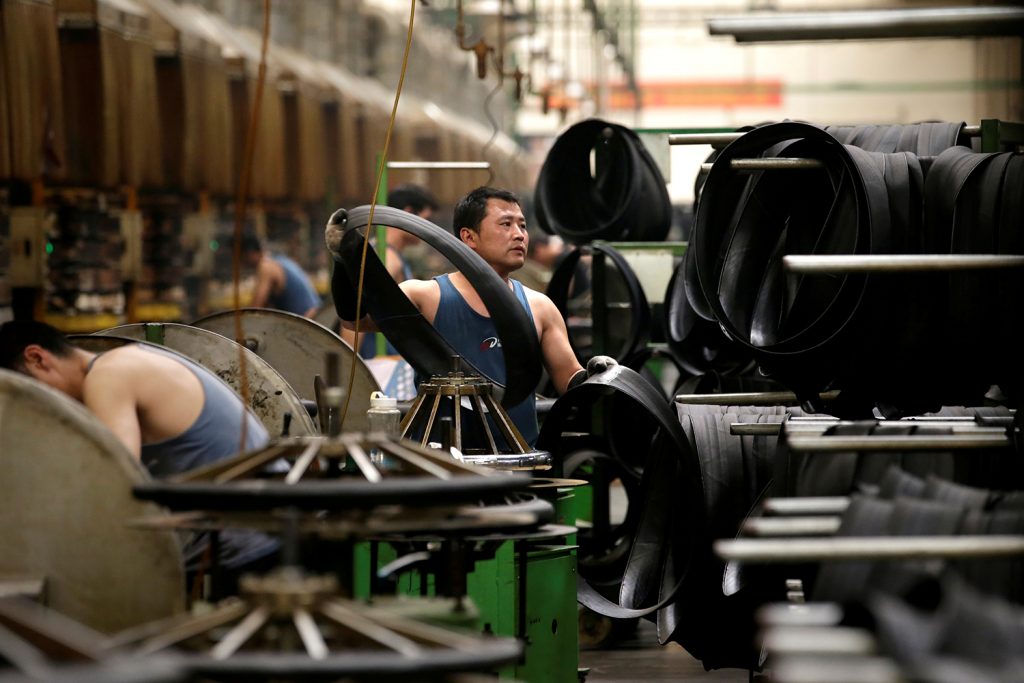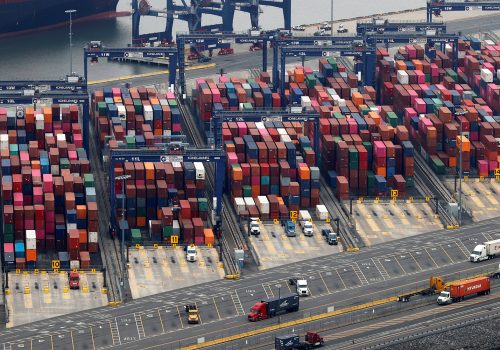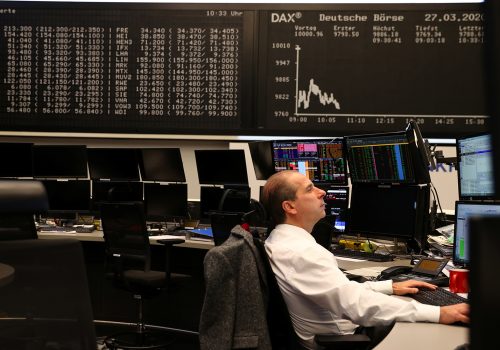90 percent of Americans now view China as a threat compared to 48 percent in 2018, according to an April edition of the Pew Research Center. In this era of distrust and misinformation, it is time for the United States to think about ways to decouple itself economically from China. The United States finds itself at an inflection point for the future of supply chain global competitiveness. China primarily sees the United States as a source for raw materials, agricultural products and energy to fuel its production of industrial and consumer products. On the other hand, the United States is deeply reliant on Chinese supply chains for medical equipment, pharmaceutical, auto, and tech products, to name a few.
The United States can no longer remain content with the notion of a Chinese economic threat arising in the distant future. The advent of COVID-19 has made it more apparent than any other time including the US-China trade war that now is the moment for the United States, European Union, and other like-minded countries to diversify supply chains away from China. This departure cannot happen overnight but with each passing day the pressure mounts for international entities to confront their dependence on Chinese sourcing. The United States and allies such as Germany, France, and the UK who have all signaled a distaste for dependence on China can use this moment to begin a supply chain campaign, departing China for other suitable manufacturing centers. Through the recently introduced US-led initiative dubbed the “Economic Prosperity Network,” companies and civil society groups across the world may soon gain access to a framework of common standards of operations across a variety of industries and begin this transition.
Why China remains manufacturing king
“Made in China” is a phrase that consumers of the world have become very familiar with over the past thirty years, as companies have recognized the burgeoning opportunities for growth and production in the massive East Asian country. As a result of its nearly 900-million-person workforce, “pre-built” factories with little oversight or regulation, tax exemptions, and past instances of devaluing the yuan against the dollar, China has been a haven for manufacturers. Since the early 1990s, China has been able to offer incentives for foreign-based businesses to relocate their facilities within its borders, resulting in the vast export market we see today.
Though there were certainly plenty of reasons for companies to move their operations to China in the 1990s and early 2000s, we have seen a slight decrease in their relative advantage over other East Asian countries as a center of production, due to their evolving sets of regulations and higher taxes. That being said, since 2009, China’s continued growth has allowed it to retain a firm grip on the title of “world’s largest exporter,” and in 2013 it surpassed the United States as “world’s largest trading nation.” With these credentials in mind it is unsurprising that during the first ten years of the century, China also became the center of information and communications technology (ICT) imports and exports globally. In a modern world that relies on its technological links for everyday function, this has made China an increasingly important trade partner, and one that seems difficult to diversify from in the near future. Just as some nations have expressed their concern with the performance of a global economy largely reliant on the US dollar, many countries and businesses have expressed their evolving preferences for a new supply chain concept not centered around China.
The alternatives
Though it may have seemed impossible to achieve such a shift when businesses became comfortable manufacturing in the cheap labor market that boasted high profit margins and low regulation, recent geopolitical instability around COVID-19 has cited more reasons for a needed transition. As the latest trade wars have plagued the operations and profits of foreign companies based in China, business owners have been forced to take production elsewhere to avoid massive tariffs. Though it certainly will not be easy to shift an entire center of operations from China, tech giants Apple, Microsoft, and Google have already stated their desire to begin the transition. By the end of 2020, these tech producers plan to move segments of their manufacturing to Vietnam and Thailand, which have proved viable alternatives to the Chinese production landscape. Other notable companies engaged in the long-term trend of shifting to Vietnam based production are Samsung, Intel, Nike, and Adidas. While these moves will likely not result in a complete shift of production in the short term, companies have begun to see the negative effects of being too reliant on one country for comprehensive supply chain and manufacturing needs.
For the past several years, companies have been exploring the new production landscape of Vietnam, which boasts lower labor costs than China and a political climate that is far more favorable. Though the labor force can be up to 40 percent cheaper than in China, access also relies on the ability of employers to appeal to the local population. One of Apple’s component manufacturers, Luxshare Precision Industry, has already made the move to Vietnam, and is “pioneering” the diversification of the supply chain in East Asia.
In addition to other East Asian markets, the United States can also shift attention to its already existing North American trade links. A recent Forbes article offered a favorable review of Mexican manufacturing in early April 2020, saying, “Mexico is the China of the Americas.” According to Ana Quintana from the Heritage Foundation, “On an average day, $1.7 billion in manufactured goods and services cross the US-Mexico border,” making a strong case for the necessity of maintaining—and growing—the North American trade relationship. Imports from Mexico have increased upwards of 15 percent since 2017, with many of the gains coming from industries affected by the US-China trade wars. Building a more supportive trade connection with our southern neighbor will result in a long-term plan to diminish reliance on China as a primary supply partner and ultimately strengthen the benefits of the recently revised US Mexico Canada Trade Agreement (USMCA).
Unfortunately for the EU and the UK, which have relied on trade along the Eurasian Silk Road for centuries, it seems that it will be much more difficult to break their reliance on Chinese manufacturing. As China aims to garner more influence and a foothold in markets abroad with its Belt-Road Initiative, European economies see benefits that cannot be matched by alternative trade approaches. Though there have been pushes for “nearshoring” production in Northern Africa and Eastern Europe in order to steer away from China’s gravitational pull, these regions simply do not have the competitive edge in infrastructure and labor availability.
COVID highlights China’s weaknesses
As the ongoing coronavirus crisis has made the world exceptionally aware of the wide-ranging outcomes of interdependent global trade, producers are looking for a way to protect their commodities and craft coordinated responses for future economic shocks. Multiplying the difficulties of these tumultuous times for businesses, is an ironic absence of the supply of information from the Chinese government, which has been accused of withholding knowledge about the crisis during its early days. According to the nonprofit Institute for Supply Management, “53 percent of businesses report having a difficult time even getting information regarding what is happening inside China.” Since it is essential for business executives and supply chain specialists to have access to updated intelligence about the environment they are operating in, the COVID-19 crisis has been further proof that running supply operations in China is not as smooth as it may have seemed.
From a fundamental perspective, it will be problematic for companies to completely shift production procedures from their current bases in China in the near term due to their entrenched component sourcing and manufacturing, which they rely on for “finished goods assemblies.” Plainly put by John Harmon, a senior analyst at Coresight Research, “Some assembly could be moved elsewhere, but these production lines take time to set up, and moreover no other country has the supply of labor of China.” Even when companies are finally able to shift their manufacturing procedures outside of China, it is inevitable that they will have to also shift their component sourcing, which will likely still be coming from inside China. Complete rearrangement of these processes and success in relocating a supply chain will ultimately rely on the determination of a company or country to commit to such a large move. The COVID-19 crisis seems to have ushered in even more urgency for such a transition. It is also vital to note here that an initial move out of China will inevitably mean an essentially irreversible modification to a company’s supply chain—this could hold long term impacts for China’s strong export economy which has relied on foreign investment and outside companies for much of their economic growth.
As a result of these indefinite environments for production, supply chain specialists are making early moves to preempt threats to their future business, keeping geographic distance as an imperative focus. Manufacturing in China used to offer cheap labor, flexible regulatory laws, and a safe haven for producers. However, in the wake of COVID-19, it seems that producers are beginning to consider the anticipation of uncertainty and threats as a more cost-effective approach to business. By decreasing geographic distance from their base of operations and moving to a less geopolitically volatile country for manufacturing, companies will be shoring up their assembly processes for the long haul.
A new geoeconomic landscape
This ongoing supply chain crisis has not only affected United States businesses, but those from all ends of the globe. In Japan, “(Prime Minister Shinzo) Abe has earmarked about 240 billion yen ($3.2 billion) to support domestic companies in decoupling their supply chains from China, especially those in high value-added manufacturing.” In France, Finance Minister Bruno Le Maire stated, “We have to decrease our dependence on a couple of large powers, in particular China, for the supply of certain products…strengthen our sovereignty in strategic value chains like cars, aerospace and medicines.” As supplies from China are restricted, 5G competitors Ericsson and Nokia have already begun to expand operations to new bases in the United States and Poland. However, as a spokesperson for the European Federation of Pharmaceutical Industries and Associations (EFPIA) rightly stated, it would be incredibly difficult at this stage of global development for a nation to continue to meet the needs of its citizens through an isolationist ideology of economics. No matter how uncomfortable it may make business executives who are in the act of transitioning their supply chains from complete reliance on China, it is undeniable that much of the supply process—namely component supply—is entrenched in its economic processes.
Comprehending the fast-moving shifts at this unique intersection of business, supply chains, and the geopolitical climate directly following a COVID-19 world, will be essential to understanding geoeconomic relations in the near term. Recent instabilities in the functioning of the global economy and rocky trade relations have resulted in the obvious need for businesses to undergo a critical rethinking of their supply strategy. Even though there was a time when it seemed China held all of the keys to manufacturing a profitable product, these unprecedented changes have prompted a complete reconsideration of what maintains success in the long term. If access to supply chains is geographically isolated in a global crisis and a company cannot rely on updated, accurate reports from the area of sourcing or production, then low costs of production become far less relevant. Since one can only expect that data will continue to reign in a technology-oriented economic future, businesses also have more reason than ever to require trust and transparency from communication with the governments of the countries they are operating in.
Though there will certainly not be a large-scale, immediate shifting of supply chains outside of China in the near-term, we have already seen many companies take action to diversify and mitigate threats stemming from any future international scale crisis. This begins with building new capacities for sourcing components from countries other than China and likely, a shift to more local production in order to reduce uncertainty of cross-border supply. However, if China manages to recover from this crisis more quickly than the rest of the world, companies may again revert to the status quo, preserving current manufacturing schemes in their search for a fast financial recovery. Moving a supply chain requires long term planning, a slowdown in production, and inevitably substantial disruption, which would further strain operations post-COVID-19.
From a geoeconomic perspective, one could predict many different outcomes from a restructuring of supply chains. From a more radical viewpoint, one may expect countries to revert to more isolationist policies as they attempt to exercise greater control over production and limit disruption to domestic economic processes. While this may be a key concern internationally, one must also acknowledge the necessity of interdependent global trade in consistently meeting the needs of citizens. With an exponentially growing world population, the requirements of maintaining living standards and access to a wide range of products for consumers will inevitably magnify. Though some may like to believe that shifting production to more local sites is an easy fix to this problem, they fail to see the clear allure of entrenched, efficient processes of manufacturers in China. A move to diversify component sourcing and product assembly will require a concerted effort by manufacturers in order to achieve a substantial move away from Chinese based operations. This determination has already been displayed by the United States, Australia, India, Japan, New Zealand, South Korea, and Vietnam, who have recently progressed in their development of the Economic Prosperity Group.
Michael B. Greenwald is director at Tiedemann Advisors. He is a fellow at Harvard Kennedy School’s Belfer Center for Science and International Affairs. He is also a senior adviser to Atlantic Council President and Chief Executive Officer Frederick Kempe. From 2015-2017, Greenwald served as the US Treasury attaché to Qatar and Kuwait.
Further reading:
Image: An employee works on the production line of a tire factory under Tianjin Wanda Tyre Group, which exports its products to countries such as U.S. and Japan, in Xingtai, Hebei province, China May 21, 2019. REUTERS/Jason Lee/File Photo



